top of page

San Francesco d'Assisi
Saint Francis of Assisi
Worksheet

The patron saint of Italy is San Francesco - Saint Francis.
He was born in Assisi in 1182. Assisi is a small, ancient town in the Italian region of Umbria and the province of Perugia. It is built high up on a hill and surrounded by an old wall.

Francesco's mother was called Pica and there is a possibility that she was French. His father was called Pietro (Peter). The family's surname was Bernardone.
The family was very wealthy. Pietro was a cloth merchant, selling fine fabrics to the rich. This meant that the family was always dressed in the finest clothes. Pietro probably travelled to France or had dealings with the French in order to buy his special fabrics.

So, Francesco grew up in a wealthy household where he heard the French language. As a young child, he would sing French songs and this impressed the local people. They gave him the nickname 'Frenchy' - Francesco. His real name was Giovanni, meaning - John.
Francesco had lots of friends. Most of them were the sons of the other rich families of Assisi. They loved to go to parties - staying out all night and sleeping during the day. They had grown up as spoilt youths who didn't need to work because their parents were rich.
They spent lots of money on going out and having a good time.

Andiamo alla festa!
In those times, wealthy parents expected their sons to fight battles in order to defend the local people. They believed that it showed a sense of duty, bravery, power and that it would bring prestige and honour to the family name.
One day, Francesco's parents watched with pride as he set off on horseback to the cheers and admiration of the local people.

However, something strange and mysterious happened! The next day, Francesco returned home. He appeared to be ill and feverish. He explained nothing and just went straight to bed. His parents were embarrassed because their son seemed weak and not at all like the heroic figure of the day before.
Nobody knows what happened to Francesco. It remains a mystery. Had he been attacked by robbers? Had he fallen ill? Had God spoken to him?
Suddenly, Francesco wanted to change his lifestyle. There would be no more fighting in battles or wanting to earn lots of money.
As he lay in bed recovering, Francesco became fascinated by animals and nature. The sound of birdsong and the beauty of nature made him feel better.
He no longer wanted to be involved in his father's business. Instead, he decided to give away all his belongings to those who lived in poverty and to live outside the walls of Assisi in the countryside with no money and no possessions.
He had always dressed in the finest clothes but from now on he decided to wear only a simple tunic, tied with a cord at the waist. Francesco's father was very disappointed and could not understand why his son would prefer to live in poverty.
Below is a photo of the actual robe worn by San Francesco. It is on display in la Basilica di San Francesco in Assisi.
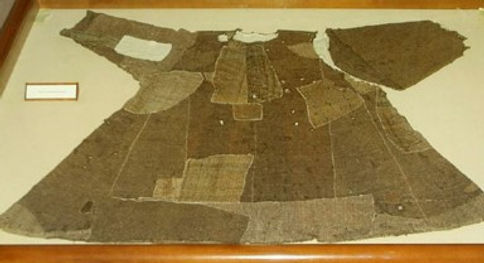
Living outside the town, Francesco's time was spent helping people who were poorly with leprosy and rebuilding old, ruined chapels. He believed that God had told him to do so.
In those days, the most feared illness was leprosy. Anyone who had the condition was cruelly forced to live outside the town in caves or huts. They even had to wear a bell around their necks so that people could hear them from a distance and run away before they came too near.
Everyone in Assisi found it impossible to believe that Francesco chose to live in such close contact with those who were so poorly.
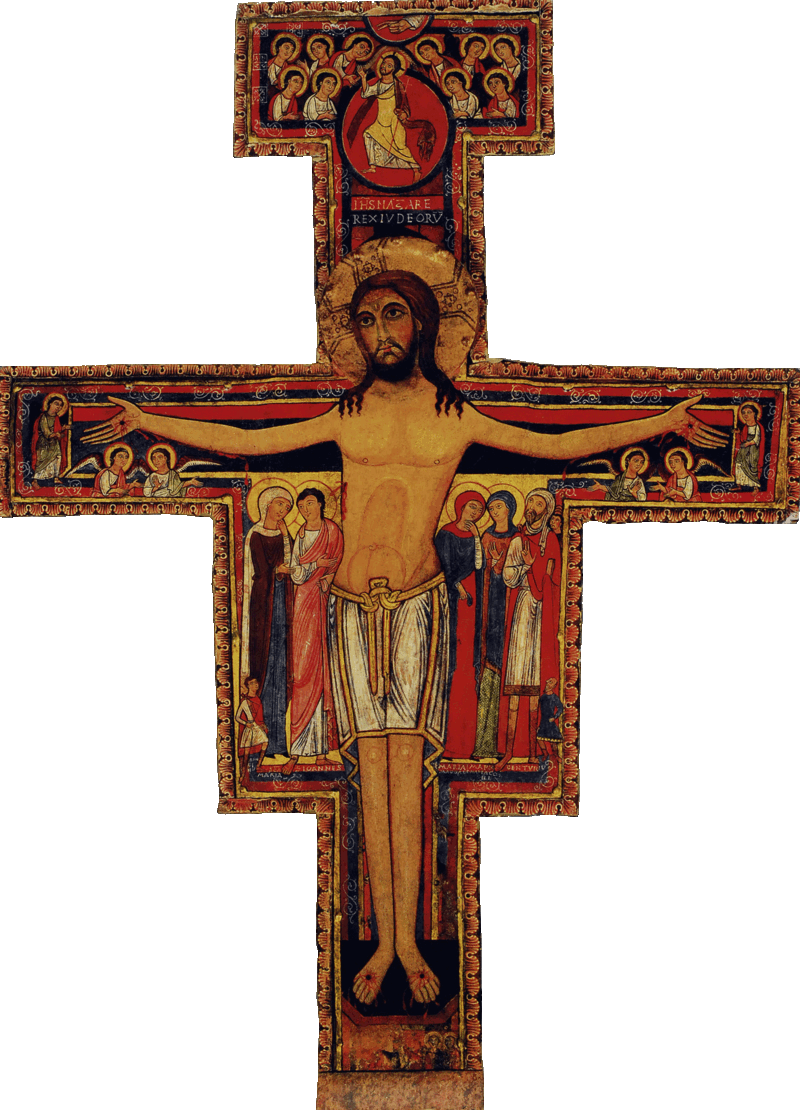
One day, when Francesco was passing in front of a ruined chapel called San Damiano, the cross hanging above the old altar spoke to him and told him to rebuild the chapel.
This cross is very famous. It is called Il Crocifisso di San Damiano and it can be seen today in the church called la Basilica di Santa Chiara in Assisi.
The cross is in the style that was common at that time: a colourful image painted onto a wooden cross shape.
Francesco obeyed the words spoken by the cross and rebuilt three chapels, stone by stone. Two of those chapels -San Damiano and Santa Maria degli Angeli - still exist today!
Below is a photo of the chapel called Santa Maria degli Angeli. It is also known as La Porziuncola, meaning: the little portion of property. Can you see the arched entrance? Do you notice how the external wall has been colourfully painted?

Question: Was Francesco missing his old, luxurious lifestyle?
Answer: No! Instead, he was just so happy with his new, simple lifestyle!
In fact, he was soon joined by his rich friends! They decided that they wanted to be as happy as Francesco by living in a simple manner. They abandoned their comfortable homes and valuable possessions. Their parents were disappointed and confused. They could not understand why they chose to live like this!
Francesco and his friends lived in the rebuilt chapel called La Porziuncola.
One of Francesco's friends was called Chiara (Clare). She decided to join the group. Her wealthy family wanted her to return home but she refused to do so. Instead, she made the decision to live in a simple manner, wearing plain clothes. Francesco cut her long hair into a short style. This was the sign that she was giving up her vanity and showing her commitment to living in simplicity, just like Francesco.
Her famous locks of hair are displayed in a glass case in la Basilica di Santa Chiara, Assisi.
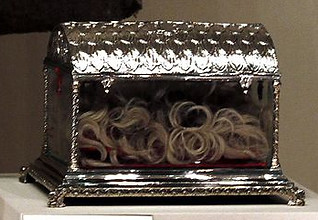
Nowadays, Clare is better known as Santa Chiara - Saint Clare. Below is a painting of Saint Clare by Italian artist Simone Martini.
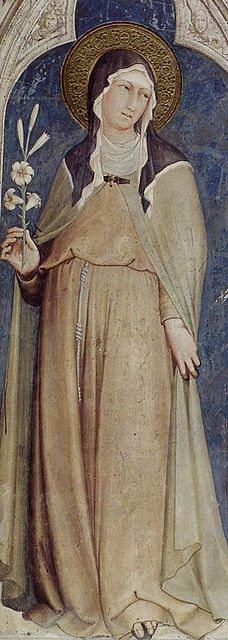
Clare and the female companions lived together in the rebuilt chapel called San Damiano. They became known as The Poor Clares. In Italian they are called Le Clarisse. Their order still exists today.
Below is an image of the church called San Damiano where Clare lived.
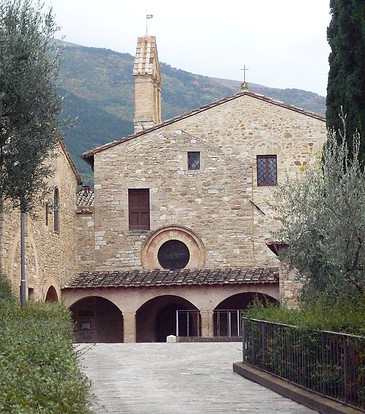
There are many famous stories about Francesco. It is said that he loved animals and he knew how to speak to them, rather like the character called Dr. Dolittle! For that reason, he is also the patron saint of animals.
On one occasion, when he was trying to speak to a group of people, the birds perching in the surrounding trees were making too much noise. Nobody could hear a word. Annoyed, Francesco scolded the noisy birds - telling them to keep quiet. Immediately, there was silence!
Another famous story involves Saint Francis and a wolf in the town of Gubbio. The wolf was scaring the local people because it was hungry but after Francesco spoke to the animal, an agreement was reached. The wolf became friends with the people because they agreed to feed it.
Francesco loved to sing and to write poetry. He wrote one of the earliest-known pieces of Italian literature in 1226. It is a poem called Cantico di Frate Sole, also known as Cantico delle Creature. In English it is called the Canticle of the Sun. It was written in the old Italian umbro language of Francesco's region: Umbria.
In his poem, he refers to everything in nature as either a brother or a sister, for example: Brother Sun and Sister Moon. Even in his everyday life, Francesco treated all parts of nature as a 'brother' or a 'sister'. A masculine noun was considered a brother - frate. A feminine noun was a sister - sora. Every part of Planet Earth was important to Francesco. That is why he is also considered to be the protector of nature and the environment.
San Francesco was the person who invented the tradition of celebrating Christmas with the Nativity scene - il presepe. On the night of Christmas Eve, in 1223, in a forest by the town of Greccio, Francesco and his companions prepared a stable with hay and brought a donkey and an ox to the scene. Everyone imagined that they were visiting the Bethlehem stable to see the newborn Baby Jesus. The enactment was so wonderful and seemed so real that it was repeated the following Christmas.

Eventually, it became the tradition to copy Francesco's idea and to recreate the Nativity scene every Christmas in countries all over the world!
Everyone was so fascinated by Francesco. People travelled from all over Europe to visit him and to hear what he had to say. One of those people was a Portuguese man called Antonio. He was so impressed by Francesco's words that he stayed in Italy as one of his supporters. Antonio is now called Saint Anthony of Padua - Sant' Antonio di Padova.
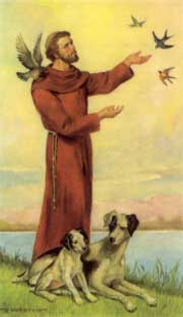
Francesco believed that:-
1. Everyone should live in peace.
2. That all creatures are important.
3. That everything belonging to nature should be cared for.
4. That money is not important. We should enjoy life without thinking all the time about how to become rich. Just like animals, there should be no need to earn money or to own possessions.
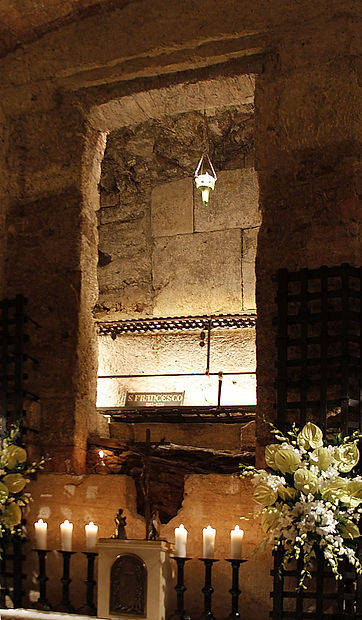
Francesco died on 3 October 1226 at the age of forty-four, shortly after writing his famous poem Cantico delle Creature.
In the final period of his life, he lost his eyesight and felt poorly.
He was canonized (made a saint) in 1228 by Pope Gregorio IX. Saint Francis is the patron saint of Italy and of animals and nature.
His special day of remembrance is every year on
4 October.
Francesco was laid to rest in la Basilica di San Francesco in Assisi. His companions were also laid to rest there and the tomb (pictured) can be visited in the basilica.
Clare died on 11 August 1253 and was canonized by Pope Alessandro IV in 1255.
She is the patron saint of the television because, even though she lived in a separate building, she had the great vision to 'see' and understand the work of Saint Francis, following and supporting his ideas about living in peace, simplicity and in harmony with nature.
Saint Clare was laid to rest in la Basilica di Santa Chiara in Assisi.
A SPECIAL 'THANK YOU'
Grazie San Francesco! Thank you Saint Francis for living your life as an example of how everyone should live: in simplicity and peace, without greed, without hatred and with respect for all people, all creatures and our planet.
Grazie mille!
Twenty facts about St. Francis
Return to Saint Francis Zone
Places in Italy
bottom of page